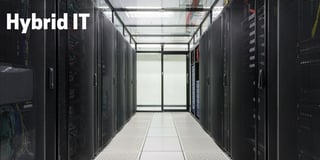 Today, the wide variety of available technology solutions opens the possibilities for organizations seeking the right combination of strategies to meet their diverse, unique needs. Luckily, companies who want to leverage the benefits of cloud computing don’t have to go “all-in” immediately; they are able to mix their traditional IT approaches with cloud-based solutions: this is described as hybrid IT. Why is traditional IT limiting? Read on for a look at hybrid IT’s importance.
Today, the wide variety of available technology solutions opens the possibilities for organizations seeking the right combination of strategies to meet their diverse, unique needs. Luckily, companies who want to leverage the benefits of cloud computing don’t have to go “all-in” immediately; they are able to mix their traditional IT approaches with cloud-based solutions: this is described as hybrid IT. Why is traditional IT limiting? Read on for a look at hybrid IT’s importance.
Data Silos: Traditional IT’s Limitation
Data silos illuminate the need for a hybrid IT approach: The data center was traditionally segmented into various silos that limit its scalability, speed and performance. Data silos are the most common example in which a data repository of fixed data is separated from the other facets of the data center. Some limitations of the data silo are:
- Slow Deployment Speed: The data is hosted on some types of data proprietary appliance such as a SAN, which is supported and maintained by a team of highly trained specialists. Even if an enterprise incorporates server virtualization, deployments must wait for the creation of virtual drives.
- Inefficiency: Data can be siloed by location or data type such as business forms, graphics and multimedia, making it difficult for users to efficiently access the data they need, when they need it.
- Complications: Data silos can also occur when departments fail to share their data due to competiveness, culture, or politics, complicating the ability to both inventory and leverage data within the organization.
More Segmentations = More Complications
Data silos are also separated by function, such as compute, storage and networking. Networking teams deploy and support the array of switches and routers that provide the network infrastructure, data specialists create and manage storage volumes, while server admins install and maintain the server fleet. Even within organizations that utilize virtualization, there is often a separation of duties that can add delays and inefficiencies to workload deployments; hybrid IT can streamline the process.
Hybrid IT Removes Institutionalized Delays
Has your organization ever experienced a slow-down due to red tape, corporate policy, or other hoops to jump through before moving on with a project? You aren’t alone. Another form of silo IT is skill-set silo in which highly skilled, highly compensated technicians who have years invested in their areas of expertise defend their established systems. Whether it’s a storage admin, server admin, network admin, or database admin, workers at your enterprise may be separated due to job function or specification. These specialists may be prone to remaining loyal to the platform in which their skills and time have been invested. As a result, companies run the risk of lagging behind new technological innovation and processes rather than leading the pack.
If today’s modern digital business is centered around the convergence of people, business and things, then today’s IT systems must act as a unified infrastructure designed for sharing, collaboration and quick deployments. IT must therefore evolve technologies as new solutions are designed to bring value and simplify the process. Culminating these new technologies such as the software defined data center, along with hyperconverged infrastructure, will provide the standardization and automation necessary to accomplish this.
As these IT environments become increasingly de-siloed, IT professionals must develop new skills and expand their areas of expertise beyond their usual discipline. Is your organization interested in creating a hybrid IT environment, leveraging your traditional IT process and pairing them with cloud-based solutions? We’d be happy to hear from you and help guide your success. Contact our experienced team of engineers today for a consultation! For more information, check out our white paper, "An Introduction to the New IT Approach Called Hybrid IT."












